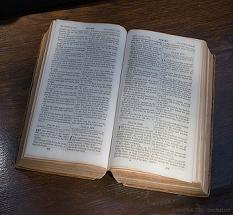Unity in Diversity
The body of Christ is one. The body of Christ is many. Which is it? One or many? The answer is trinitarian.
 When we look at the construction of 1 Corinthians 12 we see the following theme: the spiritual unity of the body of Christ though the diversity of gifts. Verses 1-12 are a discussion of spiritual gifts. At verse 12 Paul introduces the idea of the body as an example of unity in diversity. The body is one, but is composed of many parts. The body of Christ, like the Spirit of Christ, is composed of diverse elements, and yet it is one in spite of its diversity. The unity of the body requires the cooperation of the parts, and at the same time the diverse parts cannot exist or function apart from their role in the unity of the body.
When we look at the construction of 1 Corinthians 12 we see the following theme: the spiritual unity of the body of Christ though the diversity of gifts. Verses 1-12 are a discussion of spiritual gifts. At verse 12 Paul introduces the idea of the body as an example of unity in diversity. The body is one, but is composed of many parts. The body of Christ, like the Spirit of Christ, is composed of diverse elements, and yet it is one in spite of its diversity. The unity of the body requires the cooperation of the parts, and at the same time the diverse parts cannot exist or function apart from their role in the unity of the body.
Note that the unity of the Spirit and the unity of the body are not something that Christians have to achieve. The body of Christ is one. The body of Christ is many. Which is it? One or many? The answer is trinitarian. It is a function of Jesus Christ. The unity of the church already exists among Christians and is manifested through the various gifts that God has given to His people, who are "empowered by one and the same Spirit" (1 Corinthians 12:11). Paul is teaching about Christian unity here. It is an important lesson, but goes unrecognized for the most part.
Christian unity must be understood as it is manifested -- in the diversity of gifts given to God's people. At the heart of Paul's discussion about unity and diversity is the doctrine of the Trinity. The essential question or issue of the Trinity is how something can be one and three, or one and many, at the same time. How can there be unity in the midst of diversity? And how can there be diversity in unity? Again, Paul uses the human body as an example of how it works. The human body is made up of various parts -- hands, feet, eyes, ears, etc. There is a unity of the body and a diversity of its parts at the same time.
Most people aren't concerned about such issues, but Christians are. Why? Because Paul is. And Paul raises this issue because it is of ultimate value. It really is important. But why is the doctrine of the Trinity important? What actual difference does it make?
The difference that it makes has to do with the development of science and technology, and the role of science and technology regarding human life, among other things. At this point in human history people -- the populations of the world -- are dependent upon science and technology. Life as we know it could not exist without them. They are the foundation of our contemporary life support systems, i.e., food production, medicine and shelter.
It is significant that modern science and technology developed in the Christian West. They did not develop in India or China, both of which have very long histories. There was plenty of time for science and technology to develop in either India or China, but they did not. Why not? Why did they develop out of the Christian West? The short answer is that they developed out of the doctrine of the Trinity, and Christianity is the only religion or worldview that incorporates and advances such an explanation of God and of reality. And that is what the doctrine of the Trinity is -- an explanation of God and reality that fits the facts.
 A full explanation of exactly how the Trinity works is more difficult than simply stating it. For the most part the doctrine of the Trinity has been considered to be a mystery. And it is, but not because it is completely unknown. Rather, it is mysterious because it is both hard to explain and it is not completely understandable. Yet, in spite of this difficulty everyone uses the doctrine of the Trinity every day, and people have always relied upon it, though for the most part our reliance is at a subconscious level. It's sort of like relying on air. We breathe it, but for the most part it goes unseen and unnoticed as we go about our daily lives. The reality of the Trinity is, like air, a common, fundamental condition of ordinary living. People assume it to be true yet rarely acknowledge it, much less consciously think about it. But without the reality of the Trinity, life as we know it would be impossible.
A full explanation of exactly how the Trinity works is more difficult than simply stating it. For the most part the doctrine of the Trinity has been considered to be a mystery. And it is, but not because it is completely unknown. Rather, it is mysterious because it is both hard to explain and it is not completely understandable. Yet, in spite of this difficulty everyone uses the doctrine of the Trinity every day, and people have always relied upon it, though for the most part our reliance is at a subconscious level. It's sort of like relying on air. We breathe it, but for the most part it goes unseen and unnoticed as we go about our daily lives. The reality of the Trinity is, like air, a common, fundamental condition of ordinary living. People assume it to be true yet rarely acknowledge it, much less consciously think about it. But without the reality of the Trinity, life as we know it would be impossible.
Philosophically, the doctrine of the Trinity answers the fundamental issue posed by Plato known as the one and the many. All human cultures in some way have to account for the myriad of objects and phenomena in the world. We have to make sense of the world in order to live in the world. And the use of science and technology require that we make a particular kind of sense of the world.
We live in a world of objects -- things -- that are constantly changing. Yet, in this world of objects and change, there seems to be an underlying unity and stability. There is a rational consistency in the way that the world works. For instance, every human being begins as an infant and then grows into an adult and dies. Adults are very different than infants in every regard -- in fact, they are in many ways unrecognizable as being the same object. Yet we recognize that they are the same, that something has remained the same even though the infant has changed into something that is quite different from its original state. And if we trace human life back into the womb or forward into death, we see even more astonishing changes. Yet, in spite of the changes we recognize an enduring consistency, a unique individuality in the midst of change.
Or consider an acorn and an oak tree. They are completely different, yet we recognize that they share an essential identity over time. The one becomes the other such that the consistency between them is absolutely reliable. Something remains constant between these two very different things. And we see the same rational stability and constancy across the variety of objects that inhabit our world. While the world is full of diverse trees, there is still some constancy and stability to the idea of "treeness" which never seems to change.
This observation of the world of phenomena leads many cultures to believe that the diversity of things and their changes can ultimately be related back to a single thing, a unity or a oneness that remains constant in the midst of the flux of change. It is this constancy, this unity of individual things that gives them their identity. This concern is at the heart of the scientific endeavor and helps us to know how things in the world work. And the only philosophical resolution of this problem is found in the Christian doctrine of the Trinity.
About The Author
Phillip A. Ross founded http://www.Pilgrim-Platform.org in 1998, which is loaded with information about historic Christianity. In 2008 he published a exposition First Corinthians that demonstrates the Apostle Paul's opposition to worldly Christianity. His book, Arsy Varsy -- Reclaiming the Gospel in First Corinthians, 2009, shows how Paul turned the world upside down.
ArticleCity.com
[an error occurred while processing this directive]
Home » Religion and Theology Links » Unique Religion & Theology Articles » Unity in Diversity



 Articles
Articles